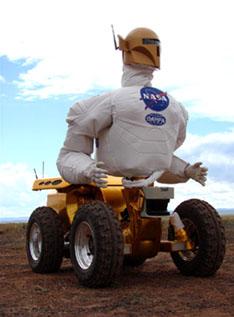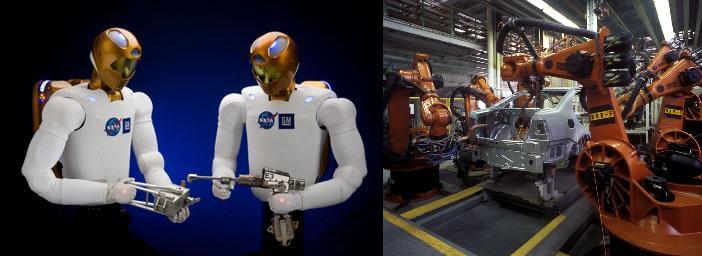
The press seems to love the new robonaut from GM and NASA, but is it really all it is hyped to be? The Robonaut 2 looks like a human from the waist up, with fully articulated limbs and hands, and an impressive golden head. Eventually, it may serve in space or on the automotive assembly line to replace humans in jobs that are too dangerous or monotonous for humans. At least, that’s the angle that NASA, GM, and most major media have taken. The Robonaut 2 does have some impressive qualifications, yet it’s nowhere near ready for space travel or fabrication. Like Honda’s Asimo, Robonaut should be seen as a promising R&D project, not a near term solution for NASA or GM. Check out the demonstration video for the Robonaut 2 below, but don’t buy into the hype just yet.
Robonaut 2 follows in the footsteps of the original Robonaut developed by NASA and DARPA ten years ago. That means it packs some impressive specs. It has five fingered hands including quadruple jointed thumbs for precise gripping. It can lift 20 lbs but comes with force sensors to prevent it from crushing delicate objects. Robonaut is sophisticated enough to shake a human hand securely without injuring it, as you can see:
The thing is, we’ve seen similar if not better capabilities for other industrial robots. ABB has an array of fast and strong robotic arms that perform amazingly well in all sorts of fabrication. Shadow’s robot hand is good at delicate work, and Harvard’s SDM can pick up a wine glass without trouble. These robot arms are at least as impressive as the Robonaut 2’s and ABB’s machines would probably work for many of the tasks GM or NASA could require.

I think the RoboNaut 2 is getting so much hype because of its humanoid shape. I get that, I went positively ga-ga over the Motoman robot the first time I saw it. Humanoid robots make a lot of sense when you want to create a robotic workforce that can directly take over for humans without changing surrounding equipment. Considering how much money has gone into getting human shapes into outer space it’s easy to hype robots that appear the same as astronauts from the waist up.
Speaking of that waist, one of the most difficult tasks for a humanoid robot is walking correctly. Asimo has spent years working to navigate and step through difficult terrain on its own. Robonaut conveniently avoids these problems by focusing on wheeled or stationary bases. That’s fine, but if you’re going to cut a humanoid robot in half, you should cut the hype by half as well.
The robot can be teleoperated or it can be given general commands and fulfill them on its own (dubbed supervised autonomy). Yet it will take years to create a Robonaut sophisticated enough to replace a human astronaut.
We have problems with just getting rovers to work well and not get stuck in dirt. Getting those rovers to work well is the better, quicker solution. The success they have had so far is a good argument against the need for humanoid robots (torsos or complete bodies). Their grappling hands work very well without resembling the fingers and thumbs of a primate. Sometimes the little shovels and other uniquely shaped attachments are vastly superior to a human-style limb.
The major reason for pursuing humanoid robots is not because the human shape is the best design, but because humans will want machines that mirror them to some degree. There’s no motivation for including these robots in your short term plans for space travel. And if you really want to look into the long-term benefits of replacing humans in space, wouldn’t modular robots make more sense? Some design that could be significantly damaged and still continue to operate seems better suited.
As for GM, do we really see the automotive manufacturing plants of the future filled with humanoid robots holding power tools? Robotic arms that are already in existence are going to get faster, stronger, and smarter. They don’t need a head modeled on a Roman centurion to work well.

I don’t want to come off as too negative here. The Robonaut is going to be an amazing project for innovating robotics. It’s just doesn’t make a lot of sense for space or cars. GM and NASA should be praised for taking on such an auspicious project but we should all realize that the major benefits of that project are likely to be unrelated to its goals. Robonaut could lead to some great breakthroughs in precision hand control, robotic programming, and AI decision making, but I doubt its going to create a robotic astronaut.
Photo and video credits: NASA


